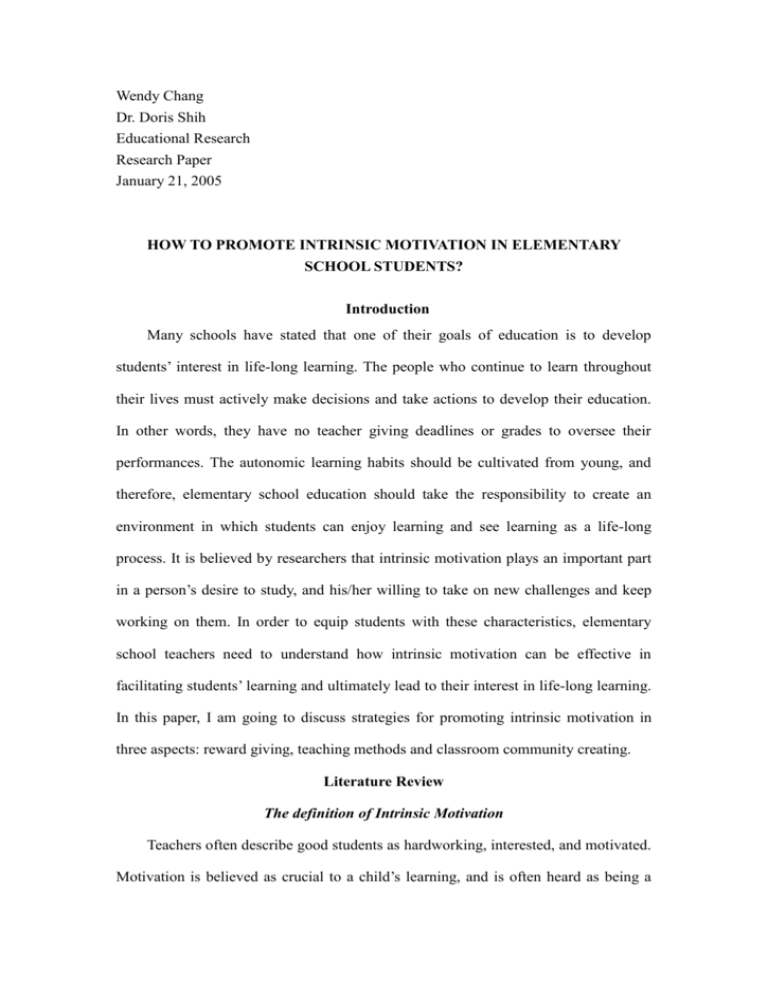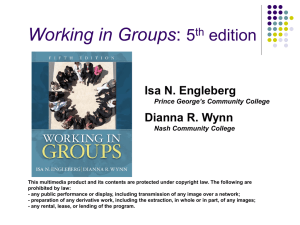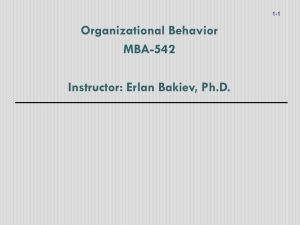How to promote intrinsic motivation in elementary school students
advertisement

Wendy Chang Dr. Doris Shih Educational Research Research Paper January 21, 2005 HOW TO PROMOTE INTRINSIC MOTIVATION IN ELEMENTARY SCHOOL STUDENTS? Introduction Many schools have stated that one of their goals of education is to develop students’ interest in life-long learning. The people who continue to learn throughout their lives must actively make decisions and take actions to develop their education. In other words, they have no teacher giving deadlines or grades to oversee their performances. The autonomic learning habits should be cultivated from young, and therefore, elementary school education should take the responsibility to create an environment in which students can enjoy learning and see learning as a life-long process. It is believed by researchers that intrinsic motivation plays an important part in a person’s desire to study, and his/her willing to take on new challenges and keep working on them. In order to equip students with these characteristics, elementary school teachers need to understand how intrinsic motivation can be effective in facilitating students’ learning and ultimately lead to their interest in life-long learning. In this paper, I am going to discuss strategies for promoting intrinsic motivation in three aspects: reward giving, teaching methods and classroom community creating. Literature Review The definition of Intrinsic Motivation Teachers often describe good students as hardworking, interested, and motivated. Motivation is believed as crucial to a child’s learning, and is often heard as being a Chang 2 major problem in schools today. Two types of motivation, intrinsic and extrinsic motivation, have been identified by Deci and Richard. They describe an intrinsically motivated person as “one who engages in an activity for the activity itself; the reward being the activity” (Deci and Richard 1994). For example, a child who cleans his room for the purpose of showing his baseball card collection to his friends is said to be intrinsically motivated. Extrinsic motivation occurs when a person completes a task because he or she wants to receive an external reward. A child who is promised a trip to the movies after cleaning his room is said to be extrinsically motivated (1994). While the majority of rewards given in school are extrinsic motivators, children learn the most when intrinsic motivation is given. SERVE contends that children who are intrinsically motivated display a number of behaviors that allow them to perform accordingly with their academic abilities. For example, children who are intrinsically motivated are deeply involved in the task at hand and experience a feeling of enjoyment (SERVE). In addition, according to Koestner (1971), an intrinsically motivated person feel that he or she can try to produce a change in the environment, and feels confident that the change will occur (1971). Methods to promote intrinsic motivation The effect of rewards Intrinsic motivation is important to the development of life-long learners, but is often hard to see in many classrooms. For example, Deci and Richard discovered that money as a reward has detrimental effects on motivation. Students became less motivated when paid money as reward. On the other hand, when students were given praise as a reward, their motivation was enhanced (1994). In addition, Deci and Richard found that when a person perceived a reward to be more than what he or she deserves, the person put forth more effort in an activity. Some rewards have been shown to interfere with the quality of learning. A study Chang 3 by Weaver showed that a reward of food distracted the subjects from the learning task, and resulted in less learning. In his experiment, the subjects, preschool students, were given pieces of candy for correct answers in a learning task, while a control group was not given anything for correct answers (Weaver, 2004). The group receiving candy proved to be slower in acquisition of the new skill, and tended to make more error than the control group (2004). This study supports the idea that when the learning task becomes a way to receive reward, it has negative effect on the learners. External rewards also interfere with the choices children make about their own learning. Cameron and Pierce (1994) examined the way students challenged themselves when graded by a teacher, and then evaluated by themselves. Eighth grade students were given two tests of both easy and difficult math problems. Students could choose a number of problems to work on, and were told that one test would receive a grade, and the other was to be completed with the student evaluation himself (1994). They found that students consistently chose easier problems for the test that was going to be graded, but chose the more difficult problems for the one that is going to be evaluated by themselves. So the results of this study indicate that the giving of grades takes a child’s attention away from the task of learning and to the task of getting the reward. Therefore, all these examples suggest that extrinsic motivators should be used sparingly, and so that they do not undermine intrinsic motivation. Creation of an autonomous classroom climate Many researchers believe that developing an autonomous classroom climate is a method to promote intrinsic motivation. Paynter (2004) claims that “when children feel in control of their environment, they are not only internally motivated to work, but also experience positive feelings of self-worth” (2004). She further says “giving children choices in their learning can be a very powerful tool in developing intrinsic motivation” (2004). She studies children doing art activities. One group of children Chang 4 was given a choice of materials to use in the activity, and the other group was given assigned materials to use. And she found that the children given a choice of materials were judged as significantly more creative, and that they spent more time on the activity (Paynter). According to Paynter, this fact has important implications. As children grow older and more demands are made on them in school, the students need to be more motivated. And students who are given more choices in their learning are assumed to be more intrinsically motivated than those who are not (Paynter). Koestner (1971) suggests many ways to give children choices in the classroom. With respect to academic learning, children can make choices in what they learn simply by choosing what book to read, and choose how to learn by deciding on what types of groups to work on, or where they will work in the classroom. In addition, students can make choices in how well they learn by helping to determine the criteria by which their homework will be graded (1971). Finally, Koestner points to the importance of including children in discussions about social and behavioral issues in the classroom, such as rules and procedures. Children given a choice in these issues will be much more likely to take them seriously, and with intrinsic motivation. Therefore, according to him, it is important to empower kids by giving them options and the opportunity to make decision. The literature review has covered three sections regarding the effect of rewards on student motivation. First, intrinsic motivation is an important trait in people that leads to success in school. Second, the common use of rewards in school has been shown to have a negative effect on learning and undermines the intrinsic motivation in children. Finally, creating an autonomous classroom climate has been suggested as an effective way to foster intrinsic motivation. Methodology I conducted a questionnaire and a telephone interview to collect data regarding Chang 5 reward giving, teaching methods and classroom community creating in elementary school. Questionnaire 10 female and 10 male elementary school students, ranging from 4th-6th graders, are the respondents of my questionnaire. They go to four different elementary schools in San-Chung City and are members of a Level 5 class in Hess Language School, Cheng-Yi Branch. The questionnaires are distributed to them in December, 2004 by their teacher at Hess, who is my friend. The purpose of the questionnaire is to find out the most common methods that the respondents’ school teachers use to reward students’ good academic performances and the respondents’ opinions about the effectiveness of those methods. The first question is fixed-alternative in which the respondents can make multiple choices. The second question provides the same alternative answers as the first question but requires the respondents to rate them according to their preferences (See Appendix A). Telephone Interview My interviewee is my class teacher (導師) in my 5th and 6th grades, Ms Liu. Ms Liu had taught in various elementary schools in Kaohsiung County and Taipei City for 29 years before she retired in 2002. Throughout her teaching career, Ms Liu had been continuously dedicated to developing innovative teaching methods and creating autonomic classroom atmosphere. The content of the interview is focused on Ms Liu’s opinions about the results of the above questionnaire and the successful methods she used to promote students’ intrinsic motivation over the years. Results and Discussion Reward giving From the result of Question 1 in Table A, we can see that the most common method elementary school teachers use to reward good academic achievement is Chang 6 “giving small presents” (16 votes), and the second common one is “giving extra points” (15 votes). “Writing encouraging words on homework/communication books” ranks the third (11 votes) and it is followed by “giving public compliments” (9 votes) and “giving verbal praises privately” (8 votes). Table A. Types of Rewards Votes Give small presents 16 Give extra points 15 Give public compliments in front of the class 9 Give verbal praises privately 8 Writing good comments on homework/communication books 11 others 2 The result of Question 2 in Table B and C indicates that girls and boys have very similar opinions about the different types of rewards. All of them chose “giving extra points” as their favorite and ranked “giving small presents” and “writing encouraging words on homework/communication books” as the second and the third. “Giving public compliments in front of the class” gets only 12 points in both genders, while “giving verbal praises privately” is the least liked one. Table B--Females Types of Rewards Points Give small presents 29 Give extra points. 25 Chang Give public compliments in front of the 7 12 class Give verbal praises privately 7 Write good comments on homework/communication books 20 others 1 Table C--Males Types of Rewards Points Give small presents 31 Give extra points 28 Give public compliments in front of the class 12 Give verbal praises privately 5 Write encouraging words on homework/communication book 16 others 1 Note: “1”=5 points, “2”= 4 points... “5”=1point According to Deci & Richard’s definition of “intrinsic motivation” and “extrinsic motivation”, the first three items in the questions, “giving small presents”, “giving extra points”, and “giving public compliments in front of the class” should be considered as methods to arouse students’ extrinsic motivation, because tangible things, such as presents and points, or public recognition are given. “Giving verbal praises privately”, on the other hand, is counted as a way to promote intrinsic motivation. “Good comments on homework/communication books” is probably in between. This is not a type of tangible reward, but for elementary school students, homework books and the communication book are examined by parents. In other Chang 8 words, children might want their teachers to write nice words not for the sake of encouraging them, but for their parents to know. The result of the questionnaire shows that most teachers rely on external rewards to motivate students, and this fact proves the researchers are right that intrinsic motivation is seldom seen in classrooms. But interestingly, teachers’ choices of rewards seem to match students’ preferences: Students’ favorite kinds of rewards are those which their teachers’ give the most often, while their least-liked kinds of rewards are given less frequently. Ms. Lui commented on this result and said it is understandable that most children preferred external rewards, because most of them only see tangible things as “real rewards”. External reward is not necessarily bad, but the effect of it is not long-lasting. So it comes the dilemma for teachers. Should teachers give external rewards to please children and get immediate effects or should they promote intrinsic motivation which leaves a longer influence on children? In Ms. Lui’s opinion, all kinds of reward are not as effective as creative and simulating teaching methods. If students really enjoy learning and have a strong motivation, their teachers do not have to rely on rewards so heavily. Teaching Methods Throughout Ms. Lui’s 29 years of teaching career, she had tried numerous teaching strategies to arouse students’ interests in learning. According to her experience, the most successful approaches include cooperative learning, allowing alternative solutions and encouraging creativity. For example, Ms Lui often incorporated group work as part of her Chinese writing class. After assigning an essay topic, she asked students to work in a group of four. The four children had to brainstorm on this topic and share their thoughts with one another. And when time was up, all the students went back to their seats to organize their thoughts and create Chang 9 their own writing. Ms. Lui believes the power of cooperative learning. “Small group discussions can help students generate more ideas. And what’s more important is that the weaker students can benefit from the pouring of ideas and won’t feel frustrated if they can’t think of too much to write,” said Lui. Ms. Lui also had unconventional teaching methods for her math class. Unlike most math classes in which students watching their teachers solve problems on the blackboard, Ms, Lui’s class never allowed students to be passive learners. Ms. Lui encouraged students to solve problems themselves instead of demonstrating the “correct solution” herself. When the class did math exercises, each member of the groups took turns going up to the front and writing down their solutions on the blackboard. If the student in the front did not know how to solve the problem, other group members were allowed to help. And what came out of this was that very often, the methods students chose to solve the problem were different. So this teaching method helped students to see that there could be various ways to approach a problem and that they should not be fixed in a single way of thinking. Finally, Ms. Lui encouraged students’ creativity. This was also reflected in her math teaching. To get the children more involved in learning, Ms. Lui made a rule that students should design their own math problems after each lesson. At first, some parents opposed to this idea, because they thought the teacher was too lazy to even make math problems for students. However, this method proved to be successful, because when students made problems themselves, they were pressured to understand the rationale of the type of problem they were working on. Ms. Lui recommended this method to other math teachers, and it also worked well in their classes and they all believed that this could further push students to think and understand the solutions for different types of problems. The three strategies Ms. Lui used to promote students’ intrinsic motivation, Chang 10 confirm Paynter’s belief that when children feel in control of their learning, they are not only internally motivated to work, but also experience positive feelings of self-worth (2004). Working with group members to generate essay ideas, allowing different solutions to a math problems and encouraging students to create their own math problems can be seen as methods to let children take the control of their learning. In these activities, children played active roles in the class while the teacher was only a guide on the side. And by actively involving in the task at hand, children could feel a greater sense of achievement. Classroom Community Creating Ms. Lui believes that in order to provoke students’ intrinsic motivation, teachers should create a class atmosphere that is both intellectually and emotionally comfortable. In other words, teachers should not only focus on academic performance but also help students to build self-confidence and self-worth. And Ms. Lui’s experience has told her that students’ positive attitudes toward themselves will eventually lead to better academic achievements. To promote self-confidence, Ms Lui created a cooperative classroom community in which all the students had equal status. For example, she empowered every kid the opportunity to be the class leader. Instead of electing a class leader for the whole semester, every student took turns to be the class leader for the day. “All students are equal in the class despite their family backgrounds and academic abilities” is Ms. Lui’s philosophy of education. In addition, students took turns correcting their classmates’ homework before the teacher corrected it herself. In other classes, the teacher assigned the group leader (排長) to be responsible for correcting students’ homework, but all students in Ms. Lui’s class shared the opportunity to do so. Ms. Lui believed that correcting classmates’ homework could help students to be more aware of what the commonly-made mistakes were and reinforced the students’ memory of correct answers. Chang 11 Both of these two strategies helped to build children’s self-confidence. By taking turns to be the class leader and correcting students’ homework, all the members of the class gained equal opportunities of learning in spite of their backgrounds and natural talents. And this type of learning environment could promote autonomous learning since the students were all actively participated in the class and no one was left out. Conclusion The most common types of rewards that elementary school teachers use are those that promote students’ extrinsic motivation, not intrinsic motivation. However, children seem to prefer external rewards and see them as more effective. But Ms. Lui believes the effect of external rewards is short-lived. The best way to promote intrinsic motivation, according to her, is to create stimulating teaching methods and an intellectually and emotionally comfortable class community where children are their own masters of learning. And the strategies she used to promote intrinsic motivation support the previous researches. A major limitation of this research, however, is that the research span is too short, and I did not have an opportunity to observe a class myself. It takes a long time to examine students’ academic performance in order to find out whether it correlates with the rewards or teaching methods being used. In the future, if possible, I could do an action research to further explore the effectiveness of different strategies to promote students’ intrinsic motivation. Chang 12 References Cameron, J., & Pierce, D. (1994). Reinforcement, reward, and Intrinsic Motivation: A meta-analysis[Electronic version]. Review of Educational Research, 64 (3). Retrieved November 3, 2004, from http://proquest.umi.com/pqdweb Deci, E. L., & Richard. R (1996). When paradigms clash: Comments on Cameron and Pierce's claim that rewards do not undermine intrinsic motivation [Electronic version]. Review of Educational Research, 66 (1). Retrieved November 3, 2004, from http://proquest.umi.com/pqdweb Koestner, R. (1971). Effects of externally mediated rewards on intrinsic motivation. Chang 13 Journal of Personality and Social Psychology, 18, 105-115. Liu, Shuang-Lan. Personal Interview. Jan. 3rd, 2005 Paynter, L. (2004). Teachers' preferences for extrinsic, intrinsic, and moral motivators, Unpublished doctoral dissertation, The Johns Hopkins University, Maryland, U. S. A. SERVE. (n.d.). What kind of motivation should schools aim to cultivate? Retrieved November 17, 2004, from http://www.serve.org/assessment/accountability/question2.html Weaver, A. D. (2004). Idiosyncratic effects of different classroom rewards on task performance and on-task behavior, Unpublished doctoral dissertation Mississippi State University, Mississippi, U. S. A. Appendix A Questionnaire for Rewards Giving in Elementary Schools English: 1. What are the most common methods do your school teachers use to reward good academic achievements, including good performances in class, on homework and on exams. (multiple choice) □ □ □ □ give small presents give extra points give public compliments in from of the class give verbal praises privately Chang 14 □ write encouraging words on homework books or the communication book □ others (please give examples) :___________________________ 2. When you perform well academically, which rewards can encourage you to continue to work hard the most? (Please put “1” for your first choice; “2” for your second choice…etc) □ □ □ □ □ □ give small presents give extra points give public compliments in from of the class give verbal praises privately write encouraging words on homework books or the communication book others (please give examples) :___________________________







